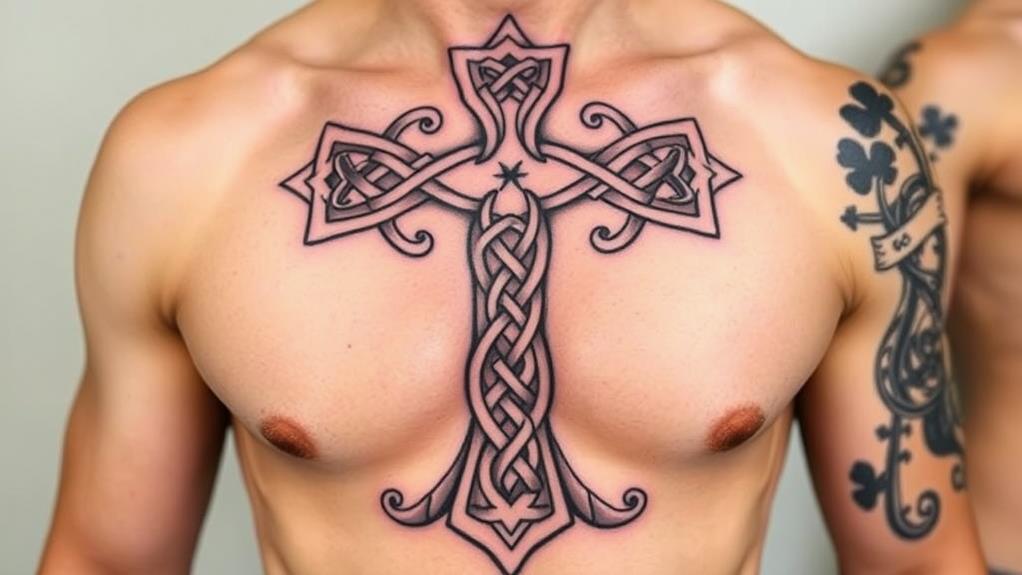I'll guide you through the mesmerizing world of Celtic Christian tattoos, where intricate knotwork designs weave ancient artistry with deep spiritual symbolism. These tattoos, rich in history and cultural significance, use interlacing patterns to symbolize life's interconnectedness and endless cycles. You'll uncover popular styles like the Celtic cross and Trinity knot, each carrying meaningful interpretations that can be customized to your personal experience. Placement and size are essential, affecting visibility and impact, so I'll help you maneuver these choices to guarantee your tattoo connects with your faith and individual story. As we delve further, you'll learn how to select a skilled artist and care for your new tattoo, preserving its beauty and significance for years to come.
History of Celtic Christian Tattoos

Celtic Christian tattoos boast a rich history steeped in symbolism and artistry. I'm fascinated by how these intricate designs blend Celtic origins with Christian influence.
The Celts, known for their love of complex patterns and interlacing lines, incorporated these elements into their artwork. When Christianity spread through Ireland and Britain, the monks adapted these Celtic designs to create illuminated manuscripts like the Book of Kells. They wove Christian themes into the knotwork, altering pagan symbols into representations of the Trinity, eternity, and the interconnectedness of all things.
Over time, these Celtic Christian designs made their way onto the skin, becoming a popular form of body art. The tattoos often feature crosses, triskelions, and intricate knots that seem to have no beginning or end.
I appreciate how the artists skillfully combine ancient traditions with modern techniques to create stunning, meaningful pieces. Whether rendered in bold black ink or lively colors, Celtic Christian tattoos are a tribute to the enduring power of this unique artistic heritage.
Symbolism in Knotwork Designs
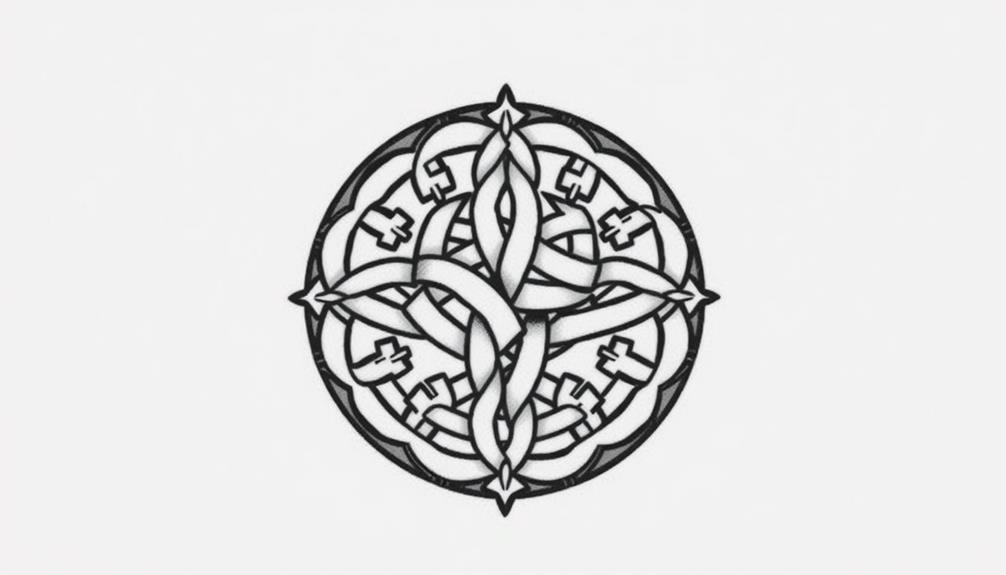
The intricate interlacing patterns in Celtic knotwork designs hold deep symbolic meaning, representing the interconnectedness of all things and the eternal nature of life.
Spirals and triskeles, commonly found in these designs, signify growth, change, and the threefold nature of existence.
I'll explain how these elements come together to create visually stunning and spiritually meaningful tattoos.
Interlacing Patterns Meaning
Interlacing patterns in Celtic knotwork designs carry deep symbolism and meaning. These intricate designs, created using various interlacing techniques, aren't only visually stunning but also hold great cultural significance.
The endless loops and weaves represent the interconnectedness of life, the continuity of time, and the eternal nature of the soul.
- The interlacing patterns symbolize the interconnectedness of all things, reminding us that we're all part of a greater whole.
- The endless loops represent the continuous cycle of life, death, and rebirth, reflecting the Celtic belief in the immortality of the soul.
- The intricate weaves signify the complexity of life's expedition and the many paths one can take, all ultimately leading to the same destination.
The cultural significance of these interlacing patterns lies in their ability to convey meaningful spiritual concepts through a visually appealing medium.
As I admire these knots, I'm reminded of the rich heritage and wisdom of the Celtic people, who skillfully wove their beliefs into every aspect of their art and lives.
Spirals and Triskeles Significance
Spirals and triskeles, two captivating elements in Celtic knotwork, carry deep symbolism that resonates with both the artist and the observer. As I investigate the intricate designs of spirals, I'm fascinated by their origins which trace back to ancient Celtic art, representing the concept of growth, eternal life, and the flow of energy.
These spiral motifs, often seen in triple formations, symbolize the power of three, a recurring theme in Celtic beliefs and Christianity, embodying the unity of the physical, mental, and spiritual domains.
Transitioning to the triskeles, I'm intrigued by its variations and the depth of its symbolism. This triple-spiral design, sometimes illustrated with three bent legs or three intertwined spirals, signifies motion, progress, and the perpetual movement of life.
It's a powerful representation of personal growth and the interconnectedness of life's path. As I examine the precise strokes and intricate patterns of these knotworks, I'm reminded of the rich fabric of Celtic and Christian heritage, woven into each design, offering not just aesthetic beauty but a significant connection to ancient wisdom and spirituality.
Popular Celtic Christian Tattoo Styles
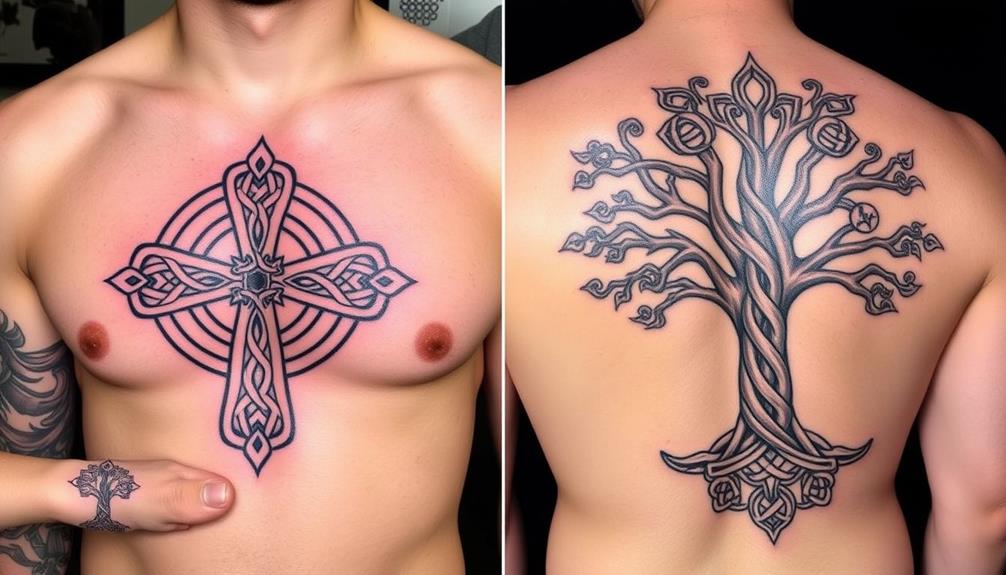
When it comes to popular Celtic Christian tattoo styles, you'll often see crosses intertwined with intricate knotwork, representing the interconnectedness of faith and eternity.
Another common design is the Trinity Knot, which symbolizes the Holy Trinity – Father, Son, and Holy Spirit – in a beautifully woven, triangular pattern.
Celtic animal tattoos also hold deep meaning, with creatures like the stag embodying Christ's suffering and resurrection, and birds signifying the Holy Spirit or the soul's odyssey.
Cross and Knotwork
Celtic cross tattoos blend Christian and pagan symbols into a stunning representation of faith and heritage. The intricate knotwork techniques used in these designs create a visually captivating and meaningful body art piece. As I investigate the various cross variations, I'm struck by the depth of symbolism embedded within each tattoo.
- The Celtic cross itself represents the bridge between the earthly and divine, with the circle symbolizing eternity and the never-ending love of God.
- Intricate knotwork patterns intertwine throughout the cross, symbolizing the interconnectedness of all things and the unity of the Trinity.
- Each knot and weave tells a story, representing the voyage of faith and the intricacies of life.
The technical skill required to create these tattoos is extraordinary. Artists must carefully plan the placement and flow of the knotwork, ensuring that each line and curve is precise and balanced. The result is a harmonious design that draws the eye and invites contemplation.
As I admire these Celtic cross tattoos, I'm reminded of the rich history and cultural significance they carry. They aren't merely decorative but serve as powerful reminders of one's faith, heritage, and the enduring human spirit.
Trinity Knot Designs
Triquetras, also known as Trinity knots, are a popular choice for Celtic Christian tattoos. These intricate designs feature three interconnected loops, symbolizing the Holy Trinity of the Father, Son, and Holy Spirit. The knot's continuous line represents the eternal nature of God and the interconnectedness of the divine. I find the symmetry and balance of Trinity knots visually stunning, making them a beautiful representation of one's faith.
The historical significance of Trinity knots traces back to ancient Celtic cultures, where they were used to decorate manuscripts and stone carvings. In modern times, these designs have been adopted by Christians who appreciate the deep symbolism and rich heritage behind the knot.
When inked on the skin, Trinity knots serve as a permanent reminder of one's beliefs and the unending love of God. Tattoo artists often incorporate additional elements like crosses or shamrocks to further emphasize the Christian meaning.
Some people choose to add a loved one's name or a meaningful quote to personalize their Trinity knot tattoo. No matter the variation, these designs are a powerful way to express one's faith and connection to Celtic roots.
Celtic Animal Tattoos
In addition to Trinity knot designs, Celtic animal tattoos offer another fascinating way to express one's faith and heritage through body art.
These tattoos often feature creatures that hold special significance in Celtic mythology and Christian symbolism. The intricate knotwork and interlacing patterns associated with Celtic art are used to create stunning representations of these animals.
- The stag represents Christ and his followers, as well as the pursuit of spiritual wisdom. Its antlers symbolize the tree of life and renewal.
- The salmon is associated with wisdom and knowledge, as seen in the legend of Fionn mac Cumhaill, who gained wisdom by touching the Salmon of Knowledge.
- The hound symbolizes loyalty, hunting, and protection. In Celtic mythology, hounds often guard the Otherworld and guide lost souls to the afterlife.
Choosing the Right Design for You
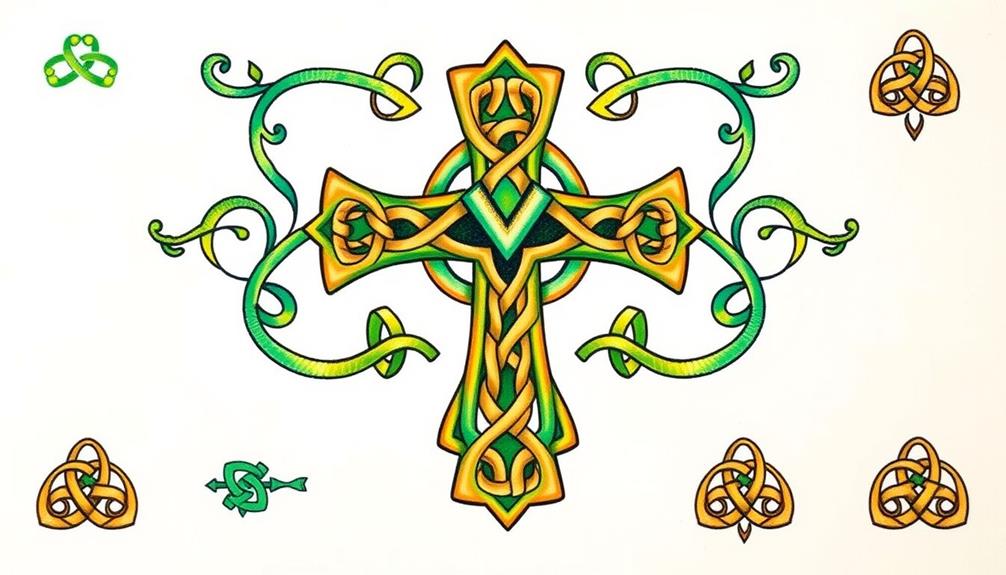
When you're considering a Celtic Christian tattoo, it's essential to choose a design that connects with you on a personal level. The intricate knots and interlacing patterns of Celtic art carry deep symbolism and meaning, so take your time to investigate the various designs and their cultural influences.
You might be drawn to the Trinity knot, symbolizing the Father, Son, and Holy Spirit, or perhaps the Celtic cross, which combines the traditional Christian cross with a nimbus, representing the divine light of Christ.
As you browse through different knotwork designs, pay attention to the way they make you feel. Do certain patterns resonate with your faith voyage or personal beliefs?
Maybe you're attracted to the continuity and interconnectedness of the eternity knot, or the way a spiral motif seems to symbolize growth and change.
Placement and Size Considerations
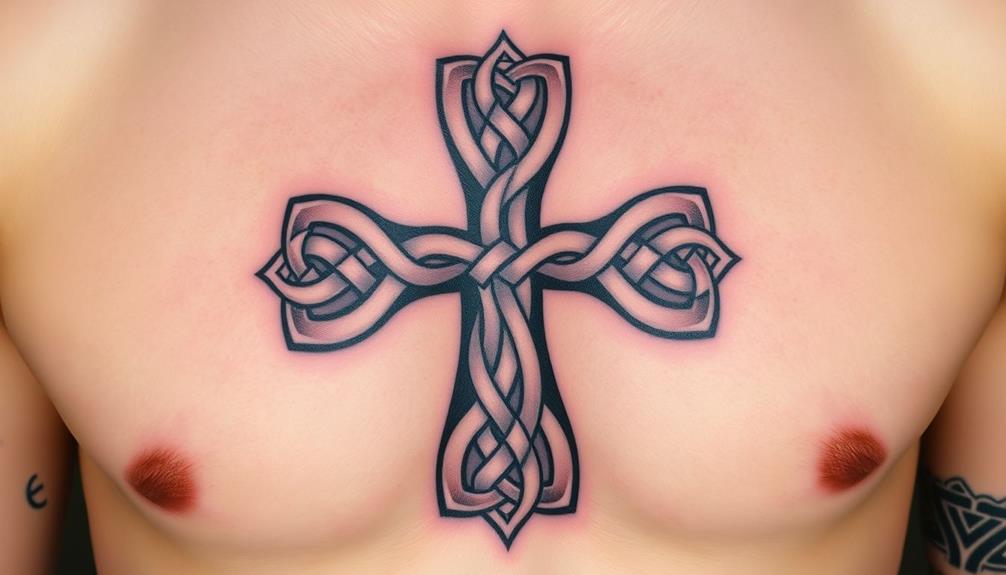
As you ponder the placement and size of your Celtic Christian tattoo, consider how it'll interact with your body's natural lines and curves. The right placement can enhance the visual impact and symbolism of your knotwork design. Here are some key considerations:
- Shoulder placement: A shoulder tattoo can be a stunning way to showcase intricate knotwork that follows the contours of your arm and shoulder blades.
- Wrist size: A small, delicate knot design can look charming on the wrist, but make sure to consider the size so it doesn't overwhelm or get distorted.
- Back design: Your back provides a larger canvas for a more elaborate Celtic cross or knotwork pattern that can flow with your spine's natural curvature.
Other placements like the ankle, thigh, chest, or leg each offer unique opportunities to integrate your tattoo's symbolism with your body's form.
Remember, the size should be proportional to the body part – a large back piece will need more detail than a subtle ankle tattoo.
Let your tattoo artist help guide you on what design will work best for your chosen placement and size.
Finding a Skilled Tattoo Artist
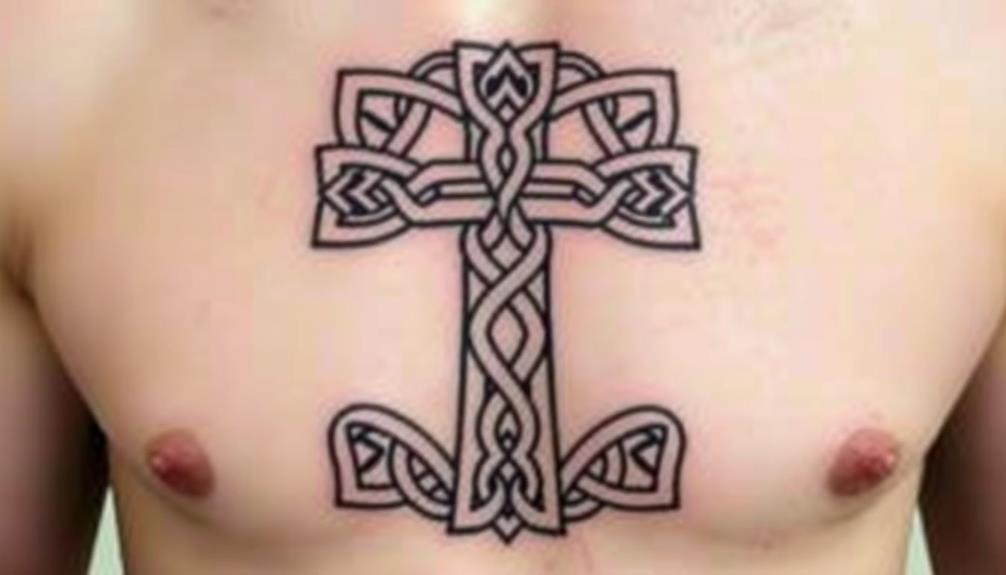
Choosing the right tattoo artist is essential when you're ready to bring your Celtic Christian design to life. You'll want someone who understands the intricate knotwork and symbolic meaning behind your chosen design.
Look for artists with experience in Celtic tattoos and a portfolio that showcases their artistic techniques. Pay attention to the precision of their lines and the consistency of their shading.
When you've found a few potential artists, schedule consultations to discuss your design in detail. Bring references and be prepared to explain the symbolism behind your tattoo.
A skilled artist will listen to your vision and offer suggestions to enhance the design while maintaining its integrity.
Don't be afraid to ask questions about their process and the tools they use. A professional tattoo artist will be happy to explain their methods and put your mind at ease.
Caring for Your New Tattoo
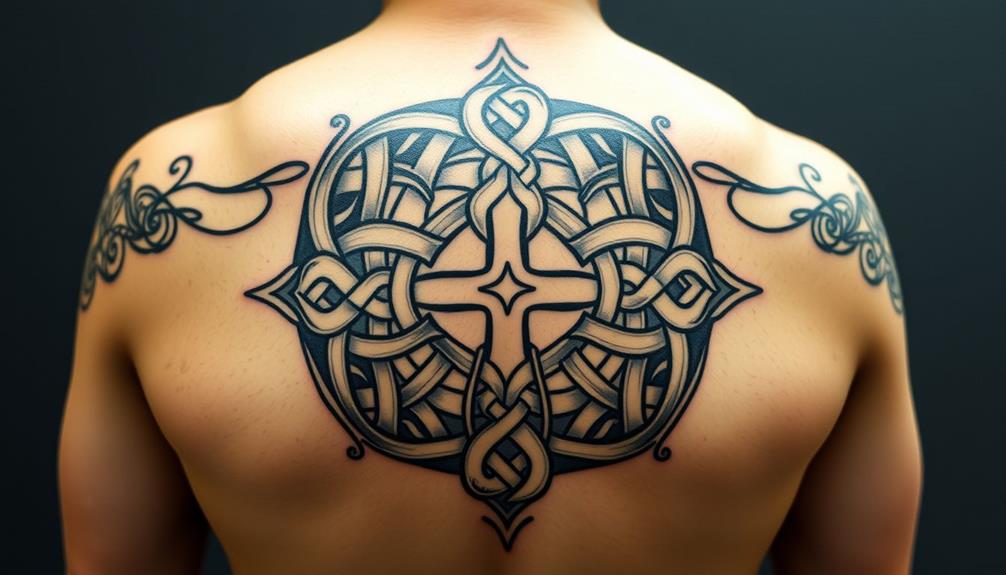
Your new Celtic Christian tattoo is a work of art of intricate design and powerful symbolism, so it's essential to take proper care of it to guarantee its longevity and vibrancy.
To make certain that your tattoo remains as stunning as the day you got it, I'll share some important tattoo aftercare tips. These steps are critical during the healing process, helping to prevent infections and maintain the tattoo's integrity.
- Keep it clean: Gently wash your tattoo with mild, fragrance-free soap and lukewarm water, patting it dry with a clean paper towel. This helps remove any excess ink, blood, or plasma.
- Moisturize regularly: Apply a thin layer of unscented, gentle moisturizer to keep your tattoo hydrated, preventing itching and scabbing. Don't overdo it, as this can suffocate the skin.
- Protect from the sun: Direct sunlight can fade your tattoo and damage the healing skin. Once it's fully healed, always apply a high-quality sunscreen to maintain its vibrancy.
Frequently Asked Questions
Are Celtic Christian Tattoos Acceptable Within the Christian Faith?
In my view, Celtic Christian tattoos are acceptable as they honor my Celtic heritage and faith. The intricate knotwork designs symbolize the interconnectedness of all things through Christ. Tattoo significance lies in visually expressing my spiritual path and identity.
Do Knotwork Designs Have Specific Meanings in Celtic Christianity?
Yes, knotwork designs in Celtic Christianity do carry specific meanings. The intricate patterns and symbols, like the Trinity Knot, represent the interconnectedness of life and faith. Each design holds historical significance, reflecting the deep roots of Celtic Christian traditions.
Can I Incorporate Other Symbols With Celtic Christian Knotwork?
Absolutely, you can combine Celtic knotwork with other symbols in your tattoo. I'd suggest incorporating meaningful Celtic symbolism like crosses, shamrocks, or Claddagh designs. Carefully consider the tattoo's placement to create a stunning, cohesive design that reflects your faith and heritage.
How Do I Ensure My Tattoo's Symbolism Aligns With My Beliefs?
I'll guarantee my tattoo aligns with my beliefs through personal reflection and thorough tattoo research. By delving into the symbolic meanings and studying the intricate details, I can create a design that authentically represents my faith and values.
Are There Any Celtic Christian Designs Considered Bad Luck?
I've found that Celtic superstitions around tattoos are mostly misconceptions. No designs are inherently bad luck in Celtic Christianity. I can help you choose a symbolically meaningful design that honors your faith and avoids any negative connotations.
